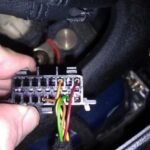Navigating the complexities of vehicle modifications, especially concerning emissions systems, can be challenging. A common question in the automotive enthusiast community revolves around the possibility of converting an OBD2 system to OBD1, particularly for older engines swapped into newer vehicles. This article delves into the nuances of this conversion, drawing from practical insights and regulatory considerations to provide a comprehensive overview.
One user in an online forum suggested a method to potentially pass emissions testing with an OBD1 engine in an OBD2 vehicle. The core idea involves temporarily utilizing OBD2-compatible components and engine control units (ECUs) for the test. Specifically, the suggestion was to use a Y7 or Y8 ECU, along with employing a “cfk trick” or physically installing a Y7/Y8 oil pan and oil pump to accommodate the crankshaft sensor required for OBD2 systems. The process would then involve reverting back to an OBD1 ECU after the emissions test is completed.
Alt: A comparison of OBD1 and OBD2 connector types, highlighting the difference in pin configurations for automotive diagnostic systems.
It’s crucial to understand the legal implications of such modifications. Regulations, particularly in regions with stringent emissions standards like California, stipulate that engine swaps must maintain or improve the emissions performance relative to the original vehicle configuration. According to the Environmental Protection Agency (EPA), installing an engine into a different vehicle is considered tampering unless the resulting vehicle configuration is identical to a certified configuration of the same or newer model year as the vehicle chassis. There needs to be a reasonable basis for knowing that emissions are not adversely affected.
While federal regulations exist, their enforcement can vary significantly at the state level. Anecdotal evidence suggests that in some states, like Delaware, individuals have successfully passed emissions tests with engine swaps that are technically not compliant with federal guidelines. The key factor in these instances often seems to be the absence of a Check Engine Light (CEL) and the functionality of the OBD2 port for scanning purposes, even if the underlying engine management system is not fully OBD2 compliant.
Alt: A car undergoing an emissions test at a certified testing facility, showcasing the equipment used to measure exhaust pollutants.
In conclusion, while there might be workarounds to seemingly “convert” an OBD2 system to accommodate an OBD1 engine for emissions testing, these methods often involve technical manipulations and potential legal ambiguities. The legality and enforcement of emissions regulations are complex and jurisdiction-dependent. It is essential to consult local regulations and consider the ethical and environmental implications before undertaking such modifications. For those seeking to maintain full legal compliance and optimal vehicle performance, adhering to certified engine configurations and consulting with automotive professionals is always recommended.
